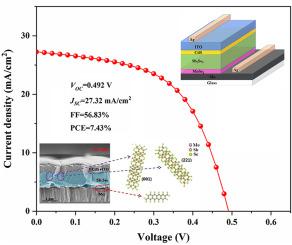Materials Today Physics ( IF 10.0 ) Pub Date : 2022-07-05 , DOI: 10.1016/j.mtphys.2022.100772 Junhui Lin , Ayyaz Mahmood , Guojie Chen , Nafees Ahmad , Mingdong Chen , Ping Fan , Shuo Chen , Rong Tang , Guangxing Liang

|
Antimony selenide (Sb2Se3) is a possible semiconductor material for next-generation solar cells and has reached excellent development in recent years. The (hk1) oriented Sb2Se3 thin films are more beneficial to the transport of carriers than the (hk0) oriented ones. The photovoltaic properties of solar cells are largely determined by the orientation of the absorber layers, thus, controlling thin film orientation is the key method to enhance the photovoltaic performance of Sb2Se3 devices. In this work, the orientations of Sb2Se3 are controlled by the preferred orientation of Mo and selenization temperature. (211) oriented Mo and a selenization temperature of 420 °C are found to facilitate the formation of large (hk1) oriented Sb2Se3 crystal grains. The substrate configuration of glass/Mo/Sb2Se3/CdS/ITO/Ag solar cells were prepared. The (hk1) oriented Sb2Se3 decreases the interfacial and bulk defects within the device, mitigates carrier recombination, and prolongs the carrier lifetime. Thus, the short-circuit current density (JSC) of the solar cell increases from 21.88 to 27.32 mA/cm2 and the champion device has achieved a power conversion efficiency of 7.43%.
中文翻译:

高效硒化锑薄膜太阳能电池的晶体取向控制与缺陷钝化
硒化锑(Sb 2 Se 3)是一种可能用于下一代太阳能电池的半导体材料,近年来取得了优异的发展。(hk1)取向的Sb 2 Se 3薄膜比(hk0)取向的薄膜更有利于载流子的传输。太阳能电池的光伏特性很大程度上取决于吸收层的取向,因此,控制薄膜取向是提高Sb 2 Se 3器件光伏性能的关键方法。在这项工作中,Sb 2 Se 3的取向由 Mo 的择优取向和硒化温度控制。发现(211)取向的Mo和420℃的硒化温度有利于形成大的(hk1)取向的Sb 2 Se 3晶粒。制备了玻璃/Mo/Sb 2 Se 3 /CdS/ITO/Ag太阳能电池的基板结构。(hk1)取向的Sb 2 Se 3减少了器件内的界面和体缺陷,减轻了载流子复合,并延长了载流子寿命。因此,太阳能电池的短路电流密度(J SC)从 21.88 增加到 27.32 mA/cm 2冠军器件实现了7.43%的电源转换效率。











































 京公网安备 11010802027423号
京公网安备 11010802027423号